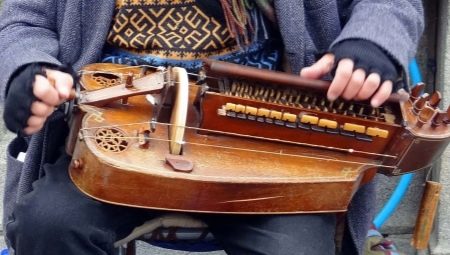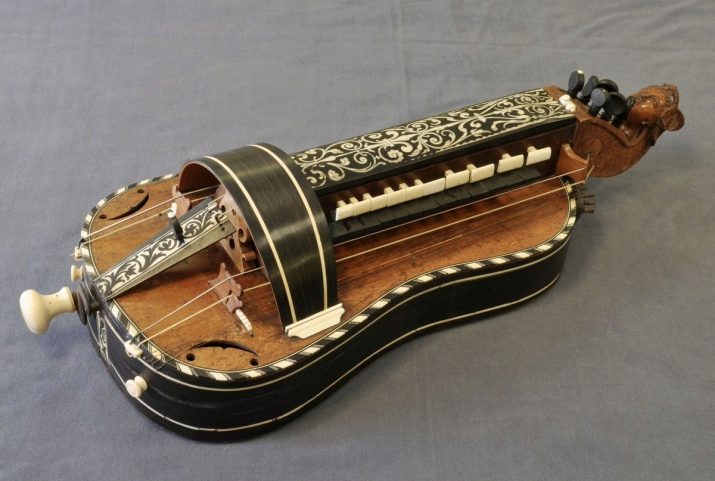Wheeled lyre: characteristics and device

The wheeled lyre is an old folk musical instrument with an interesting device. About what its history is, what features it has and not only, we will tell below.

History of appearance
The wheeled lyre is an ancient musical instrument, the closest relative of which is the organistrum and nickelharpa. It belongs to the family of stringed plucked musical instruments.

This type of lyre has been known since the 10th century, but at that time it was used, if we talk about Western Europe, mainly in monasteries, serving as an accompaniment for church chants. but from there the wheeled lyre was eventually successfully replaced by the organ, after which it began to be used among the people.

Initially, the wheeled lyre was a fairly large instrument that two musicians had to play, but a little later it underwent a number of certain changes and became more compact.
By the 15th century, the wheeled lyre began to be used by wandering musicians who wandered the streets of cities, performing certain musical compositions. However, during this period, the instrument did not receive much popularity and became associated with many of the lower strata of the population, the poor and the crippled.

At the same time the wheeled lyre found its way to the territory of Russia, Ukraine and Belarus, but it did not find much demand here either. It was also played by wandering musicians in these countries, performing various songs, and sometimes telling to the unpretentious melody of an epic.

Only by the 18th century, the wheeled lyre received a lot of attention from not only itinerant singers and musicians, but also from the aristocracy. This period became a real heyday for the instrument.At this time, the upper strata of society suddenly showed interest in the life and culture of the common people. The wheeled lyre was especially interesting for them. So, for this instrument, several classical compositions appeared, and he himself began to be considered secular.
It is worth noting that this instrument was in demand not only in the music field, but also among artists who often depicted it on their canvases.

The wheeled lyre, as it spread, received a variety of names in each of the countries. So, for example, in Ukraine it began to be called "Don snout", and in England - "hardy-hardy". The latter name, by the way, has become firmly established in world culture.

In Ukraine, this instrument also flourished around this period, capturing the 19th century as well. Many believed that the wheeled lyre would become even more popular than the bandura in the field of music. It began to be used when performing music at weddings, at various fairs and other folk festivals.

In our countries, lyre players, who were called lyre players, existed until the 30s of the 20th century. There are several versions associated with what happened to them next. According to one of them, wandering musicians were simply eliminated, and according to the other, they were transferred due to the fact that the impoverished classes were abolished.

Nowadays, the lyre on wheels can be heard infrequently. However, this folk instrument is still used by some ensembles in their repertoires, there are even masters who are engaged in the production of this musical instrument.
It is also noteworthy that earlier this instrument was interesting to rock musicians due to its unusual sound. So, it was often used by the well-known bands Led Zeppelin, In Extremo.

In Belarus, the wheeled lyre can be heard in the State Orchestra or in the orchestral group of the State Folk Choir, where it is officially included. In Russia, it is often used by Andrei Vinogradov, a fairly well-known musician and composer.

How does it work?
In appearance, such a folk musical instrument as the wheeled lyre vaguely resembles a harp, but it does not have much in common with it. This lyre differs from many stringed instruments not only by the peculiarities of its structure, but also by its sound production. So, for this, not the bow familiar to everyone is involved, but a wooden wheel, which will be described in detail a little below.

The lyre usually has 3 vein strings, as well as a deep wooden body, reminiscent of the figure 8 or a violin case, and a neck. Flat instrument decks, of which 2, are flat and wide, and also have bent shells. In the upper part of the lyre there is a head with wooden pegs. It is thanks to this part that the strings are tuned.

In the inner part of the lyre, there is a wooden wheel mounted on an axle. He is assigned the role of a permanent bow. For him, a slot is specially located in the deck, thanks to which its rim looks outward, it is usually well rubbed with resin to improve the quality of the music played. In order to minimize the possibility of damage to this part of the tool, a special bast guard in the shape of an arc is intended for it.

Above in the soundboard there are resonator holes, there is also a keyboard device with sills. There are only 12-13 keys in the instrument, they all look like narrow strips of wood with small projections. With each press, these same projections contact the strings. They are firmly attached to the instrument, which allows you to move them as you want, thereby making the alignment of the scale.

As for the strings, each has its own name. The first one is called "spivanitsa" or "melodic", two, and sometimes there may be more, the remaining - "bourdon", "tenor" or "bayorok", when playing the lyre they sound continuously, but you can turn them off.Disconnection of bourdon strings occurs by pulling them away from the wheel and attaching them to the pins.

The first string goes through the body of the instrument, the other two - outside it. Each of them is close enough to the wheel, in contact with its rim. So, when the wheel rotates, the sound of the instrument is produced.
As for the material of the strings themselves, animal veins were previously most often used for this, but now metal or nylon is used for this.

Sound description
Lyre has a diatonic scale, the volume of which is about 2 octaves. The sound of a wheeled lyre vaguely resembles the sound of a bagpipe. It is monotonous, loud enough, powerful and bright, but somewhat nasal and buzzing. To soften it, linen or woolen fibers were usually used. They wrapped the strings in those places where they should have come into contact with the rim of the wheel.

In this case, the winding of the drone strings had to be given special attention and a greater amount of material, otherwise the sound could turn out to be too dull or, on the contrary, too harsh, which was clearly audible in the upper range.
The sound quality, its evenness is ensured by the wheel, or rather its smooth surface and centering accuracy. The lyre player performs the music itself by means of the keys located on the sides of the body.

Technique of the game
The wheeled lyre can be played both sitting and standing. In the first case, the lyre is put on the knees, in the second, it is hung with a belt attached to the body of the instrument over the shoulder, while guiding its neck to the left at an angle.

This position of the instrument contributes to the departure of the keys from the first, melodic string under the influence of its own gravity. With the help of his right hand, the performer rotates the wheel, while with his left hand he presses the keys.









Many thanks! In the film "Evenings on a Farm near Dikanka" this instrument sounds.